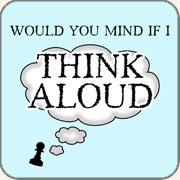
Teachers often use this think aloud technique to verbalize what normally happens internally as a student is reading and processing information. By doing this, teachers model how to be problem solvers and critical thinkers, and give students the vocabulary and processes they need to solve problems.
Students who use this method start by verbalizing their inner thought processes, communicating out loud what they are thinking and feeling as they read. As they get better at this, what they say out loud soon becomes an inner dialogue, and they become expert thinkers and problem solvers. Students working in pairs or groups can listen in on what others are thinking, how they are analyzing the problems, and what thought processes they use to come to their final conclusions. One student can “think aloud” as they read while the other student write down what their partner said. Then, they can switch roles and compare notes. This helps to engrain the information into their understandings even further. Gradually, it becomes natural for students to use what they hear and convert it to their own inner dialogue.
When students use the Think Aloud method, it gives the teachers the opportunity to listen in and see what is causing students the most difficulty, and can access their strengths and weaknesses.
Parents, tutors and teachers can use the Think Aloud method help students become critical thinkers. Numerous studies have been done on this topic, and one educational resource gives this great example of how adults can model their thought process out loud:
For example, suppose during math class you’d like students to estimate the number of pencils in a school. Introduce the strategy by saying, “The strategy I am going to use today is estimation. We use it to . . . It is useful because . . . When we estimate, we . . .”
Next say, “I am going to think aloud as I estimate the number of pencils in our school. I want you to listen and jot down my ideas and actions.” Then, think aloud as you perform the task.
Your think-aloud might go something like this:
“Hmmmmmm. So, let me start by estimating the number of students in the building. Let’s see. There are 5 grades; first grade, second grade, third grade, fourth grade, fifth grade, plus kindergarten. So, that makes 6 grades because 5 plus 1 equals 6. And there are 2 classes at each grade level, right? So, that makes 12 classes in all because 6 times 2 is 12. Okay, now I have to figure out how many students in all. Well, how many in this class? [Counts.] Fifteen, right? Okay, I’m going to assume that 15 is average. So, if there are 12 classes with 15 students in each class, that makes, let’s see, if it were 10 classes it would be 150 because 10 times 15 is 150. Then 2 more classes would be 2 times 15, and 2 times 15 is 30, so I add 30 to 150 and get 180. So, there are about 180 students in the school. I also have to add 12 to 180 because the school has 12 teachers, and teachers use pencils, too. So that is 192 people with pencils.”
By taking the problem solving method apart step by step, students can get a better idea of how they can dissect a problem and eventually they won’t have to verbalize their thought process, it will become a natural, internal way of thinking.
Parents of young children know that children are sponges and parrots. They absorb everything they hear and repeat it back, (sometimes at the most inappropriate times!) Parents can use this to their advantage by walking their child through their daily thought processes, even if it is not academically related.
“How am I going to organize these toys? First, I’ll put them all on the floor in front of me. Then I’ll separate them into toys with wheels and toys without…” it is think sort of thing that children will internalize and eventually attempt to duplicate on their own.
Classrooms are buzzing with the thoughts of critical thinkers and problem solvers, and students are learning in a whole new way how to process information and comprehend what they are reading. https://www.teachervision.com/skill-builder/problem-solving/48546.html
